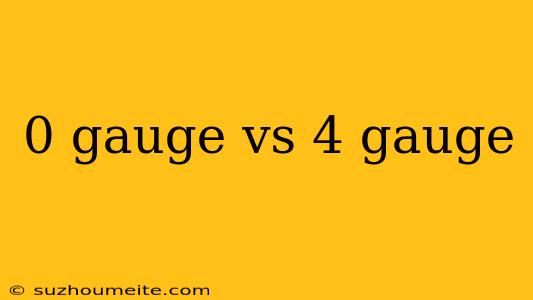0 Gauge vs 4 Gauge: Understanding the Difference
When it comes to choosing the right wire gauge for your electrical projects, it's essential to understand the differences between various gauge sizes. Two of the most common wire gauges used in automotive and industrial applications are 0 gauge and 4 gauge. In this article, we'll delve into the details of each gauge size, their applications, and the key differences between them.
What is Wire Gauge?
Before we dive into the comparison, let's quickly discuss what wire gauge is. Wire gauge refers to the diameter of a wire, with smaller gauge numbers indicating thicker wires and larger gauge numbers indicating thinner wires. The American Wire Gauge (AWG) system is the standard method of measuring wire gauge sizes.
0 Gauge Wire
Characteristics:
- Thicker diameter: 0 gauge wire has a larger diameter than 4 gauge wire, measuring approximately 0.324 inches (8.23 mm) in diameter.
- Higher current capacity: 0 gauge wire can handle higher currents due to its larger cross-sectional area, making it suitable for heavy-duty applications.
- Lower resistance: The thicker diameter of 0 gauge wire results in lower resistance, reducing energy loss and heat buildup.
Applications:
- High-power audio systems: 0 gauge wire is often used in high-power car audio systems to ensure maximum power delivery to amplifiers and speakers.
- Heavy-duty industrial applications: 0 gauge wire is used in industrial settings for powering heavy machinery and equipment.
4 Gauge Wire
Characteristics:
- Thinner diameter: 4 gauge wire has a smaller diameter than 0 gauge wire, measuring approximately 0.204 inches (5.18 mm) in diameter.
- Lower current capacity: 4 gauge wire has a lower current capacity than 0 gauge wire, making it suitable for smaller, lower-power applications.
- Higher resistance: The thinner diameter of 4 gauge wire results in higher resistance, which can lead to energy loss and heat buildup.
Applications:
- Light-duty automotive applications: 4 gauge wire is commonly used in light-duty automotive applications, such as powering car stereos and accessories.
- Small machinery and equipment: 4 gauge wire is used in small machinery and equipment, such as generators and pumps.
Key Differences
- Diameter: 0 gauge wire has a larger diameter than 4 gauge wire.
- Current capacity: 0 gauge wire can handle higher currents than 4 gauge wire.
- Resistance: 0 gauge wire has lower resistance than 4 gauge wire.
- Applications: 0 gauge wire is used in heavy-duty applications, while 4 gauge wire is used in light-duty applications.
Conclusion
In conclusion, 0 gauge and 4 gauge wires serve different purposes in various applications. Understanding the differences between these gauge sizes is crucial for selecting the right wire for your project. Remember to consider factors such as current capacity, resistance, and application requirements when choosing between 0 gauge and 4 gauge wire.
